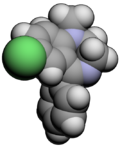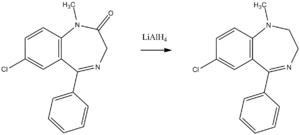- Medazepam
-
Medazepam 

Systematic (IUPAC) name 9-chloro-2-methyl-6-phenyl-2,5-diazabicyclo[5.4.0]undeca-5,8,10,12-tetraene Clinical data AHFS/Drugs.com International Drug Names Pregnancy cat. ? Legal status Schedule IV(US) Routes Oral Pharmacokinetic data Bioavailability ? Metabolism Hepatic Half-life 36-150 hours Excretion Renal Identifiers CAS number 2898-12-6 
ATC code N05BA03 PubChem CID 4041 DrugBank none ChemSpider 3901 
UNII P0J3387W3S 
KEGG D01292 
ChEMBL CHEMBL28333 
Chemical data Formula C16H15ClN2 Mol. mass 270.8 SMILES eMolecules & PubChem  (what is this?) (verify)
(what is this?) (verify)Medazepam is a drug which is a benzodiazepine derivative. It possesses anxiolytic, anticonvulsant, sedative and skeletal muscle relaxant properties.
It is known by the following brand names: Nobrium, Rudotel, Raporan, Ansilan.[1] Medazepam is a long acting benzodiazepine drug. The half-life of medazepam is 36 – 200 hours.[2]
Contents
Pharmacology
Benzodiazepine drugs including medazepam increase the inhibitory processes in the cerebral cortex by allosteric modulation of the GABA receptor.[3] Benzodiazepines may also act via micromolar benzodiazepine binding sites as Ca2+ channel blockers and significantly inhibited depolarization-sensitive calcium uptake in experiments with cell components from rat brains. This has been conjectured as a mechanism for high dose effects against seizures in a study.[4] It has major active benzodiazepine metabolites which gives it a more prolonged therapeutic effects after administration.[5]
The Committee on the Review of Medicines
The Committee on the Review of Medicines (UK) carried out a review into benzodiazepines due to significant concerns of tolerance, drug dependence and benzodiazepine withdrawal problems and other adverse effects. The committee found that benzodiazepines do not have any antidepressant or analgesic properties and are therefore unsuitable treatments for conditions such as depression, tension headaches and dysmenorrhoea. Benzodiazepines are also not beneficial in the treatment of psychosis due to a lack of efficacy. The committee also recommended against benzodiazepines being used in the treatment of anxiety or insomnia in children. The committee was in agreement with the Institute of Medicine (USA) and the conclusions of a study carried out by the White House Office of Drug Policy and the National Institute on Drug Abuse (USA) that there was little evidence that long term use of benzodiazepine hypnotics were benefitial in the treatment of insomnia due to the development of tolerance. Benzodiazepines tended to lose their sleep promoting properties within 3 – 14 days of continuous use and in the treatment of anxiety the committee found that there was little convincing evidence that benzodiazepines retained efficacy in the treatment of anxiety after 4 months continuous use due to the development of tolerance. The committee found that the regular use of benzodiazepines caused the development of dependence characterised by tolerance to the therapeutic effects of benzodiazepines and the development of the benzodiazepine withdrawal syndrome including symptoms such as anxiety, apprehension, tremor, insomnia, nausea, and vomiting upon cessation of benzodiazepine use. Withdrawal symptoms tended to develop within 24 hours on the cessation of a short acting benzodiazepine and within 3 – 10 days after the cessation of a more long acting benzodiazepine. Withdrawal effects could occur after treatment lasting only 2 weeks at therapeutic dose levels however withdrawal effects tended to occur with habitual use beyond 2 weeks and were more likely the higher the dose. The withdrawal symptoms may appear to be similar to the original condition. The committee recommended that all benzodiazepine treatment be withdrawn gradually and recommended that benzodiazepine treatment be used only in carefully selected patients and that therapy be limited to short term use only. It was noted in the review that alcohol can potentiate the central nervous system depressant effects of benzodiazepines and should be avoided. The central nervous system depressant effects of benzodiazepines may make driving or operating machinery dangerous and the elderly are more prone to these adverse effects. In the neonate high single doses or repeated low doses have been reported to produce hypotonia, poor sucking, and hypothermia in the neonate and irregularities in the fetal heart. Benzodiazepines should be avoided in lactation. Withdrawal from benzodiazepines should be gradual as abrupt withdrawal from high doses of benzodiazepines may cause confusion, toxic psychosis, convulsions, or a condition resembling delirium tremens. Abrupt withdrawal from lower doses may cause depression, nervousness, rebound insomnia, irritability, sweating, and diarrhoea.[6]
Chemistry
7-chloro-2,3-dihydro-1-methyl-5-phenyl-1H-1,4-benzodiazepine (5.1.40), has been suggested to be synthesized in various ways. The first is the reduction of the carbonyl group in diazepam by lithium aluminum hydride.
- Sternbach, L. H.; Reeder, E.; Archer, G. A. (1963). The Journal of Organic Chemistry 28 (9): 2456. doi:10.1021/jo01044a514.
- E. Reeder, L.H. Sternbach, U.S. Patent 3,109,843 (1963).
The second way of making medazepam consists of the initial reduction of the carbonyl group by lithium aluminum hydride into 7-chloro-5-phenyl-2,3-dihydro-1H-1,4-benzodiazepin- 2-one—the first intermediate product in the synthesis of diazepam—which is synthesized by the cyclocondensation of 2-amino-5-chlorobenzophenone with glycine ethyl ester into 7-chloro-2,3-dihydro-5-phenyl-1H-1,4-benzodiazepine, and the subsequent methylation of the secondary amine nitrogen atom of the resulting product by methyl iodide, using sodium hydride as a base.
- S. Inaba, H. Nagata, DE 1934385 (1971).
- G.A. Archer, E. Fells, L.H. Sternbach, U.S. Patent 3,131,178 (1964).
The third method of making medazepam consists of a new way of making 7-chloro-2,3- dihydro-5-phenyl-1H-1,4-benzodiazepine, which consists in heterocyclization of 1-(2,5-dichlorophenyl)-1-phenylimine with ethylenediamine. The starting 1-(2,5- dichlorophenyl)-1-phenylimine is synthesized by the reaction of 2,5-dichlorobenzonitrile with phenylmagnesium bromide.
- S. Inaba, H.Nagata, DE 1934385 (1969).
Finally, a method of making medazepam from 4-chloro-N-methylaniline is suggested. The last is reacted with ethyleneimine in the presence of aluminum chloride, giving N- (4-chlorophenyl)-N-methylethylenediamine. Acylation of the resulting product with benzoyl chloride gives the respective amide, which cyclizes into the desired medazepam using phosphorus oxychloride.
- K.H. Heinrich, DE 1695188 (1967).
- K.H. Heinrich, DE 1795811 (1967).
See also:
- Wunsch, K. H.; Dettmann, H.; Schonberg, S.; Chem. Ber. 1969, 102, 3891.
Various modifications of the described methods have been suggested.
- S. Inaba, K. Ishizumi, T. Okamoto, H. Yamamoto, Chem. Pharm. Bull., 20, 1628 (1972).
- M. Mihalic, V. Sunjic, F. Kajfez, M. Zinic, J. Heterocycl. Chem., 14, 941 (1977).
See also
- Benzodiazepine
- Benzodiazepine dependence
- Benzodiazepine withdrawal syndrome
- Long term effects of benzodiazepines
References
- ^ Encyclopedia of Drugs: Benzodiazepines
- ^ Professor heather Ashton (April 2007). "BENZODIAZEPINE EQUIVALENCY TABLE". http://www.bcnc.org.uk/equivalence.html. Retrieved September 23, 2007.
- ^ Zakusov VV; Ostrovskaya RU, Kozhechkin SN, Markovich VV, Molodavkin GM, Voronina TA. (October 1977). "Further evidence for GABA-ergic mechanisms in the action of benzodiazepines.". Archives internationales de pharmacodynamie et de thérapie. 229 (2): 313–26. PMID 23084.
- ^ Taft WC; DeLorenzo RJ (May 1984). "Micromolar-affinity benzodiazepine receptors regulate voltage-sensitive calcium channels in nerve terminal preparations" (PDF). Proc Natl Acad Sci USA 81 (10): 3118–22. doi:10.1073/pnas.81.10.3118. PMC 345232. PMID 6328498. http://www.pnas.org/cgi/reprint/81/10/3118.pdf.
- ^ Jochemsen R, Breimer DD (1984). "Pharmacokinetics of benzodiazepines: metabolic pathways and plasma level profiles". Curr Med Res Opin 8 Suppl 4: 60–79. PMID 6144464.
- ^ Committee on the Review of Medicines (March 29, 1980). "Systematic review of the benzodiazepines. Guidelines for data sheets on diazepam, chlordiazepoxide, medazepam, clorazepate, lorazepam, oxazepam, temazepam, triazolam, nitrazepam, and flurazepam. Committee on the Review of Medicines". Br Med J. 280 (6218): 910–2. doi:10.1136/bmj.280.6218.910. PMC 1601049. PMID 7388368. http://www.pubmedcentral.nih.gov/articlerender.fcgi?tool=pmcentrez&artid=1601049.
External links
Benzodiazepine derivatives 1,4-Benzodiazepines Bromazepam · Camazepam · Carburazepam · Chlordiazepoxide · Cinolazepam · Clonazepam · Clorazepate · Cyprazepam · Delorazepam · Demoxepam · Devazepide * · Diazepam · Doxefazepam · Elfazepam · Ethyl carfluzepate · Ethyl dirazepate · Ethyl loflazepate · Fletazepam · Fludiazepam · Flunitrazepam · Flurazepam · Flutemazepam · Flutoprazepam · Fosazepam · Gidazepam · Halazepam · Iclazepam · Ketazolam · Lorazepam · Lormetazepam · Meclonazepam · Medazepam · Menitrazepam · Metaclazepam · Motrazepam · Nimetazepam · Nitrazepam · Nitrazepate · Nordazepam · Nortetrazepam · Oxazepam · Phenazepam · Pinazepam · Pivoxazepam · Prazepam · Proflazepam · Quazepam · QH-II-66 · Reclazepam · Ro5-2904 · Ro5-4864 * · Sulazepam · Temazepam · Tetrazepam · Tifluadom * · Tolufazepam · Tuclazepam · Uldazepam
1,5-Benzodiazepines Arfendazam · Clobazam · CP-1414S · Lofendazam · Triflubazam
2,3-Benzodiazepines * Girisopam · GYKI-52466 · GYKI-52895 · Nerisopam · Talampanel · Tofisopam
Triazolobenzodiazepines Adinazolam · Alprazolam · Estazolam · Flubromazolam · Triazolam
Imidazobenzodiazepines Bretazenil · Climazolam · FG-8205 · Flumazenil · Imidazenil · L-655,708 · Loprazolam · Midazolam · PWZ-029 · Remimazolam · Ro15-4513 · Ro48-6791 · Ro48-8684 · Sarmazenil · SH-053-R-CH3-2′F
Oxazolobenzodiazepines Cloxazolam · Flutazolam · Haloxazolam · Mexazolam · Oxazolam
Thienodiazepines Bentazepam · Brotizolam · Ciclotizolam · Clotiazepam · Etizolam · Olanzapine *
Pyridodiazepines Lopirazepam · Zapizolam
Pyrazolodiazepines Pyrrolodiazepines Tetrahydroisoquinobenzodiazepines Benzodiazepine prodrugs * atypical activity profile (not GABAA receptor ligands)Categories:- Benzodiazepines
- Organochlorides
Wikimedia Foundation. 2010.





